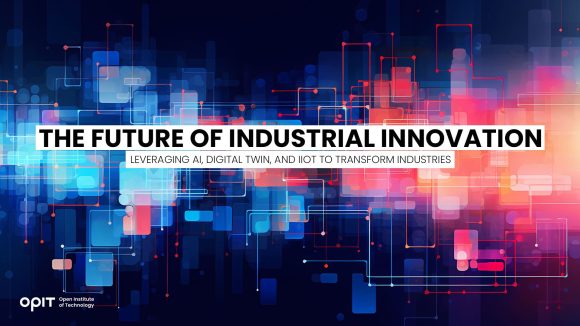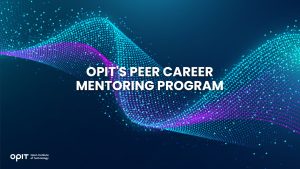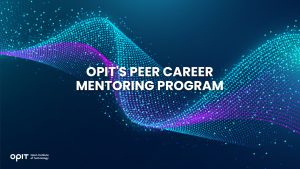The Future of Industrial Innovation: Leveraging AI, Digital Twins, and IIoT to Transform Industries


In April 2025, the Open Institute of Technology (OPIT) invited Professor Andrea Gozzi, Head of Strategy at Partnership for the Digital Industries Ecosystem at Siemens, Italy, to talk about how new technologies are transforming industry.
Industry Is Driving Technological Innovation
According to Gozzi, who teaches in the OPIT BSc in Digital Business and MSc in Digital Business and Innovation programs, many of the young people he meets imagine that the development of technology like artificial intelligence (AI) and the Internet of Things (IoT) is being led by digital companies like Amazon and Apple. But, he adds, they haven’t really considered how industry is utilizing and leading in these fields.
Industry includes markets such as energy, aviation, and manufacturing. Gozzi explains how new technologies are transforming these industries and, in turn, how these industries are pioneering new technologies. As a result, industry represents a growing job market, especially for OPIT graduates.
Challenges to Industry
Gozzi started his discussion by explaining the modern challenges facing the industry today and how these challenges necessitate innovation. He identified three principal challenges:
- Geopolitical instability events like the war in Ukraine and changing tariffs are undermining supply lines, complicating contracts, and making sales unpredictable.
- Labor shortages are being caused by changing demographics and changing culture. Gozzi explained that in the past, people worked for one company for their entire lives, learning specialist skills and adding value throughout their working lives. Today, people tend to change jobs several times throughout their working lives, so to maximize their value, they need to be brought up to speed quicker, and companies need strategies to retain knowledge despite labor churn.
- Sustainability pressures are on the rise both in terms of meeting green regulations and ensuring that expensive factories provide a long-term return on investment.
To adapt to these challenges, industry is looking to develop innovative technological solutions.
Opportunities: AI, Digital Twins, Industrial IoT, and Robotics
Having set the scene, Gozzi dove into the types of technologies that industry is pioneering to adapt to challenge, and how they are pushing these technologies beyond their mainstream potential.
Artificial Intelligence (AI)
Gozzi explained how AI promises to be an industry game changer, especially in the quest to go from automated to adaptive manufacturing. Automated manufacturing can create products based on existing programming, recreating the same product perfectly every time while eliminating human error.
But the goal is to create machines that don’t just create one thing but can create anything, adapting as designs change. Adaptive manufacturing is one of the core goals of Industry 4.0, which is the next Industrial Revolution that is seeing automated, interconnected factories. Gozzi shared a compelling example of applications by Rolls-Royce for airplane engine production.
AI powers machines to handle more complex tasks independently, which requires them to be networked and connected. As a result, factories can collect data from every area and use it to optimize supply chains and resource allocation. This enables predictive maintenance, reducing downtime by around 50%, and scheduling activity, reducing yield losses by around 40%. Since factories represent major investments, maximizing productivity is essential to achieving a strong return on investment (ROI).
This same data is increasingly being used to iterate and test prototypes in the digital twin environment.
Digital Twins
According to Gozzi, today’s factories are created with intelligent interconnected machines that are adaptable and extendable and can provide strategic insights. The entire manufacturing system is connected by silent threads of information that can turn siloed data into a much larger picture.
These threads form the neural network of digital twins, which are virtual replicas of physical systems that can be used to monitor and optimize operations, simulate actions before execution, and accelerate innovation. New production techniques and designs can be tested virtually before being tested in the real world, allowing processes to be optimized for quality and efficiency. Here, Gozzi shared a compelling example from Siemens’ accelerator ecosystem which creates replicas of factories in the metaverse.
IIoT and Robotics
In the factories themselves, manufacturers rely on advanced robotics connected by the Industrial Internet of Things (IIoT) to carry out tasks independently. IIoT ensures that a centralized intelligence integrates every element of production in real-time. This not only allows robots to do their jobs but also ensures that issues can be identified and solutions executed through the digital twin. The digital twin can also be used to teach robots new tasks tested and piloted virtually in the digital twin.
Meanwhile, robots must be mobile, AI-driven, and integrated into the factory’s ecosystem. It is AI that has enabled robots to become aware of their environment, enabling new behaviors such as picking pieces from a non-uniform set and placing them where they are required. This may seem small, but it is something that robots have never been able to do and represents one of the biggest recent breakthroughs in manufacturing.
AI is also enabling robots to safely work alongside human workers in manufacturing settings. These collaborative robots, called “cobots,” are another recent development that promises to be transformative.
Cybersecurity
Gozzi explained that all this requires advanced connectivity and a closed network with a “zero trust” architecture to mitigate security threats. Hackers, viruses, and other network failures don’t just represent the potential loss of valuable and confidential data, but also a major safety risk if cobots are interfered with and begin to act unsafely.
Powerful and secure industrial closed networks are being enabled by 5G, but these networks still need to be monitored by cybersecurity continuously in real-time.
The Future of Industry
Industry is modernizing quickly, and technology is playing an increasingly important role. This is manifesting in the development of smart adaptive factories using a mix of AI, advanced robotics, and digital twins. Industrial IoT, strong connected networks, and advanced cybersecurity support this. The demand for talent that understands these technologies and their applications will only increase in the coming years.
Moreover, Gozzi reassures students that there is no question that technology will replace real people in some positions. Humans will still be needed to collaborate and work side by side with robots. This will require people to learn new skills, in particular, a data-driven mindset and approach to problem-solving.
Both OPIT’s BSc in Digital Business and MSc in Digital Business and Innovation are designed to prepare students for these kinds of careers.
Related posts

Source:
- Raconteur, published on November 06th, 2025
Many firms have conducted successful Artificial Intelligence (AI) pilot projects, but scaling them across departments and workflows remains a challenge. Inference costs, data silos, talent gaps and poor alignment with business strategy are just some of the issues that leave organisations trapped in pilot purgatory. This inability to scale successful experiments means AI’s potential for improving enterprise efficiency, decision-making and innovation isn’t fully realised. So what’s the solution?
Although it’s not a magic bullet, an AI operating model is really the foundation for scaling pilot projects up to enterprise-wide deployments. Essentially it’s a structured framework that defines how the organisation develops, deploys and governs AI. By bringing together infrastructure, data, people, and governance in a flexible and secure way, it ensures that AI delivers value at scale while remaining ethical and compliant.
“A successful AI proof-of-concept is like building a single race car that can go fast,” says Professor Yu Xiong, chair of business analytics at the UK-based Surrey Business School. “An efficient AI technology operations model, however, is the entire system – the processes, tools, and team structures – for continuously manufacturing, maintaining, and safely operating an entire fleet of cars.”
But while the importance of this framework is clear, how should enterprises establish and embed it?
“It begins with a clear strategy that defines objectives, desired outcomes, and measurable success criteria, such as model performance, bias detection, and regulatory compliance metrics,” says Professor Azadeh Haratiannezhadi, co-founder of generative AI company Taktify and professor of generative AI in cybersecurity at OPIT – the Open Institute of Technology.
Platforms, tools and MLOps pipelines that enable models to be deployed, monitored and scaled in a safe and efficient way are also essential in practical terms.
“Tools and infrastructure must also be selected with transparency, cost, and governance in mind,” says Efrain Ruh, continental chief technology officer for Europe at Digitate. “Crucially, organisations need to continuously monitor the evolving AI landscape and adapt their models to new capabilities and market offerings.”
An open approach
The most effective AI operating models are also founded on openness, interoperability and modularity. Open source platforms and tools provide greater control over data, deployment environments and costs, for example. These characteristics can help enterprises to avoid vendor lock-in, successfully align AI to business culture and values, and embed it safely into cross-department workflows.
“Modularity and platformisation…avoids building isolated ‘silos’ for each project,” explains professor Xiong. “Instead, it provides a shared, reusable ‘AI platform’ that integrates toolchains for data preparation, model training, deployment, monitoring, and retraining. This drastically improves efficiency and reduces the cost of redundant work.”
A strong data strategy is equally vital for ensuring high-quality performance and reducing bias. Ideally, the AI operating model should be cloud and LLM agnostic too.
“This allows organisations to coordinate and orchestrate AI agents from various sources, whether that’s internal or 3rd party,” says Babak Hodjat, global chief technology officer of AI at Cognizant. “The interoperability also means businesses can adopt an agile iterative process for AI projects that is guided by measuring efficiency, productivity, and quality gains, while guaranteeing trust and safety are built into all elements of design and implementation.”
A robust AI operating model should feature clear objectives for compliance, security and data privacy, as well as accountability structures. Richard Corbridge, chief information officer of Segro, advises organisations to: “Start small with well-scoped pilots that solve real pain points, then bake in repeatable patterns, data contracts, test harnesses, explainability checks and rollback plans, so learning can be scaled without multiplying risk. If you don’t codify how models are approved, deployed, monitored and retired, you won’t get past pilot purgatory.”
Of course, technology alone can’t drive successful AI adoption at scale: the right skills and culture are also essential for embedding AI across the enterprise.
“Multidisciplinary teams that combine technical expertise in AI, security, and governance with deep business knowledge create a foundation for sustainable adoption,” says Professor Haratiannezhadi. “Ongoing training ensures staff acquire advanced AI skills while understanding associated risks and responsibilities.”
Ultimately, an AI operating model is the playbook that enables an enterprise to use AI responsibly and effectively at scale. By drawing together governance, technological infrastructure, cultural change and open collaboration, it supports the shift from isolated experiments to the kind of sustainable AI capability that can drive competitive advantage.
In other words, it’s the foundation for turning ambition into reality, and finally escaping pilot purgatory for good.

The Open Institute of Technology (OPIT) is the perfect place for those looking to master the core skills and gain the fundamental knowledge they need to enter the exciting and dynamic environment of the tech industry. While OPIT’s various degrees and courses unlock the doors to numerous careers, students may not know exactly which line of work they wish to enter, or how, exactly, to take the next steps.
That’s why, as well as providing exceptional online education in fields like Responsible AI, Computer Science, and Digital Business, OPIT also offers an array of career-related services, like the Peer Career Mentoring Program. Designed to provide the expert advice and support students need, this program helps students and alumni gain inspiration and insight to map out their future careers.
Introducing the OPIT Peer Career Mentoring Program
As the name implies, OPIT’s Peer Career Mentoring Program is about connecting students and alumni with experienced peers to provide insights, guidance, and mentorship and support their next steps on both a personal and professional level.
It provides a highly supportive and empowering space in which current and former learners can receive career-related advice and guidance, harnessing the rich and varied experiences of the OPIT community to accelerate growth and development.
Meet the Mentors
Plenty of experienced, expert mentors have already signed up to play their part in the Peer Career Mentoring Program at OPIT. They include managers, analysts, researchers, and more, all ready and eager to share the benefits of their experience and their unique perspectives on the tech industry, careers in tech, and the educational experience at OPIT.
Examples include:
- Marco Lorenzi: Having graduated from the MSc in Applied Data Science and AI program at OPIT, Marco has since progressed to a role as a Prompt Engineer at RWS Group and is passionate about supporting younger learners as they take their first steps into the workforce or seek career evolution.
- Antonio Amendolagine: Antonio graduated from the OPIT MSc in Applied Data Science and AI and currently works as a Product Marketing and CRM Manager with MER MEC SpA, focusing on international B2B businesses. Like other mentors in the program, he enjoys helping students feel more confident about achieving their future aims.
- Asya Mantovani: Asya took the MSc in Responsible AI program at OPIT before taking the next steps in her career as a Software Engineer with Accenture, one of the largest IT companies in the world, and a trusted partner of the institute. With a firm belief in knowledge-sharing and mutual support, she’s eager to help students progress and succeed.
The Value of the Peer Mentoring Program
The OPIT Peer Career Mentoring Program is an invaluable source of support, inspiration, motivation, and guidance for the many students and graduates of OPIT who feel the need for a helping hand or guiding light to help them find the way or make the right decisions moving forward. It’s a program built around the sharing of wisdom, skills, and insights, designed to empower all who take part.
Every student is different. Some have very clear, fixed, and firm objectives in mind for their futures. Others may have a slightly more vague outline of where they want to go and what they want to do. Others live more in the moment, focusing purely on the here and now, but not thinking too far ahead. All of these different types of people may need guidance and support from time to time, and peer mentoring provides that.
This program is also just one of many ways in which OPIT bridges the gaps between learners around the world, creating a whole community of students and educators, linked together by their shared passions for technology and development. So, even though you may study remotely at OPIT, you never need to feel alone or isolated from your peers.
Additional Career Services Offered by OPIT
The Peer Career Mentoring Program is just one part of the larger array of career services that students enjoy at the Open Institute of Technology.
- Career Coaching and Support: Students can schedule one-to-one sessions with the institute’s experts to receive insightful feedback, flexibly customized to their exact needs and situation. They can request resume audits, hone their interview skills, and develop action plans for the future, all with the help of experienced, expert coaches.
- Resource Hub: Maybe you need help differentiating between various career paths, or seeing where your degree might take you. Or you need a bit of assistance in handling the challenges of the job-hunting process. Either way, the OPIT Resource Hub contains the in-depth guides you need to get ahead and gain practical skills to confidently move forward.
- Career Events: Regularly, OPIT hosts online career event sessions with industry experts and leaders as guest speakers about the topics that most interest today’s tech students and graduates. You can join workshops to sharpen your skills and become a better prospect in the job market, or just listen to the lessons and insights of the pros.
- Internship Opportunities: There are few better ways to begin your professional journey than an internship at a top-tier company. OPIT unlocks the doors to numerous internship roles with trusted institute partners, as well as additional professional and project opportunities where you can get hands-on work experience at a high level.
In addition to the above, OPIT also teams up with an array of leading organizations around the world, including some of the biggest names, including AWS, Accenture, and Hype. Through this network of trust, OPIT facilitates students’ steps into the world of work.
Start Your Study Journey Today
As well as the Peer Career Mentoring Program, OPIT provides numerous other exciting advantages for those who enroll, including progressive assessments, round-the-clock support, affordable rates, and a team of international professors from top universities with real-world experience in technology. In short, it’s the perfect place to push forward and get the knowledge you need to succeed.
So, if you’re eager to become a tech leader of tomorrow, learn more about OPIT today.
Have questions?
Visit our FAQ page or get in touch with us!
Write us at +39 335 576 0263
Get in touch at hello@opit.com
Talk to one of our Study Advisors
We are international
We can speak in:


